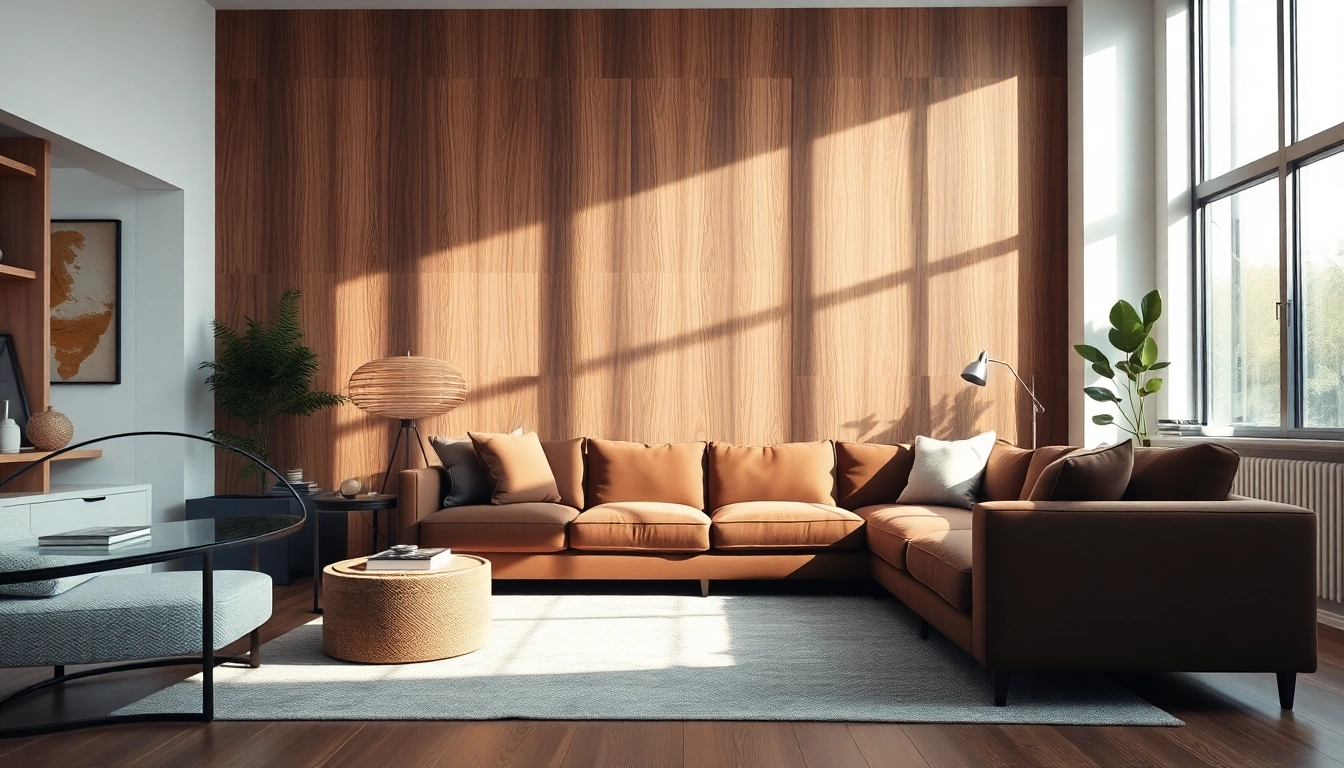Elevate Your Interiors with Stunning Wood Wall Accent Panels
Understanding Wood Wall Accent Panels
What are Wood Wall Accent Panels?
Wood wall accent panels are decorative wall coverings made from various types of wood designed to enhance the aesthetic appeal of interior spaces. These panels can range from reclaimed barn wood to sophisticated wooden veneer finishes, giving homeowners and designers an array of options to create unique focal points in any room. They provide not only a visual texture but also warmth and a natural element to an environment. By integrating wood wall accent panels into your design, you can significantly alter the ambiance of your space.
Benefits of Using Wood Wall Accent Panels
Utilizing wood wall accent panels in your interior design brings numerous benefits. First and foremost, these panels act as visually striking elements that can transform a bland wall into a piece of art. They provide unparalleled warmth and comfort to a space, helping to create an inviting environment. Additionally, wood has insulating properties, which can contribute to energy efficiency in a home by regulating temperature. From a practical standpoint, wood panels can help hide imperfections in walls and provide an additional layer of sound insulation, thus improving acoustics.
Furthermore, wood wall accent panels come in a diverse range of styles, finishes, and colors, making it easy to find options that align with various design aesthetics—from rustic to modern chic. Finally, the easy installation process and low maintenance required for wood panels contribute to their growing popularity among homeowners and designers alike.
Types of Wood Wall Accent Panels
There are several types of wood wall accent panels available on the market, each with distinct characteristics and suited to different design styles. Below are some of the most popular types:
- Veneer Panels: Made from thin slices of wood that are bonded onto a substrate, veneer panels are lightweight and available in various designs. They offer an elegant look while being cost-effective.
- Reclaimed Wood Panels: These panels are crafted from repurposed wood, often featuring a rustic charm and rich history. They’re perfect for creating a vintage or farmhouse aesthetic.
- Engineered Wood Panels: Composed of bonded layers of wood, these panels offer increased durability and moisture resistance, making them suitable for various environments.
- Solid Wood Panels: These panels are made from solid pieces of wood and are often used for a more traditional look. They provide natural beauty and durability but often come at a higher price point.
- 3D Panels: With their unique textures and patterns, 3D panels add depth and interest, making them popular for feature walls and modern designs.
Choosing the Right Wood Wall Accent Panels for Your Space
Factors to Consider When Selecting Panels
Choosing the right wood wall accent panels involves considering multiple factors to ensure compatibility with your design vision and functional needs. Here are some crucial elements to consider:
- Room Function: Evaluate the room where the panels will be installed. For instance, moisture-resistant panels are advisable for bathrooms and kitchens, while living rooms may benefit from aesthetic appeal.
- Style and Décor: Identify your existing décor and design style. Choose panels that complement or contrast strategically to create visual interest, whether that’s a minimalist approach or a bold statement.
- Color and Finish: Wood wall accent panels come in various finishes, from natural wood stains to painted options. Selecting the right finish can enhance the overall aesthetics of your space.
- Budget: Prices for wood panels vary significantly based on the type of wood and design intricacies. Setting a reasonable budget before making a selection can help guide your choices effectively.
- Installation Method: Consider whether you prefer a straightforward installation method. Some panels are designed for easy installation, while others may require professional help.
Popular Styles and Finishes
When it comes to styles and finishes for wood wall accent panels, the options are nearly limitless. Here are some styles that are currently trending:
- Rustic Farmhouse: Reclaimed wood panels that highlight natural imperfections create a warm, inviting space reminiscent of countryside living.
- Modern Minimalist: Sleek, smooth panel designs in light woods paired with white or neutral tones offer a contemporary and sophisticated look.
- Industrial Chic: Dark-stained or distressed wood panels complement metallic and concrete elements, ideal for loft-style spaces.
- Scandinavian Design: Light wood finishes combined with soft color palettes embrace the Scandinavian aesthetic, emphasizing functionality and simplicity.
Matching Panels with Your Interior Design
The alignment of wood wall accent panels with your overall interior design is critical in achieving a cohesive look. Here are a few approaches to harmonize the panels with your space:
- Color Coordination: Match the wood tones of your panels with existing furniture and décor items. Contrast can also work well when done thoughtfully. For instance, light wood panels can pop against dark furnishings.
- Texture Play: Consider the textures in your room. Pair smooth wood panels with coarser fabrics or materials for a dynamic look that keeps the eye engaged.
- Focal Points: Use wood accent panels to create a focal point in a room, such as behind a bed or a sofa. This can anchor the space and draw attention.
- Eclectic Mixing: Don’t shy away from mixing different styles. For example, you can combine traditional wood panels with modern art pieces to create a visually stimulating environment.
Installation of Wood Wall Accent Panels
Tools and Materials Needed
Installation of wood wall accent panels can be a rewarding DIY project that enhances your home aesthetics. However, it’s essential to gather the right tools and materials before diving in:
- Tools:
- Measuring tape
- Level
- Circular saw or jigsaw for cutting panels
- Drill and drill bits for screws or wall anchors
- Hammer (if using nails)
- Paintbrush or roller (if painting)
- Utility knife for trimming
- Safety goggles and gloves for protection
- Materials:
- Wood wall accent panels
- Adhesive or nails/screws for installation
- Wood filler for gaps
- Caulk for sealing edges
- Paint or stain, if desired
Step-by-Step Installation Guide
Installing wood wall accent panels can be broken down into manageable steps. Here’s a simple guide to help you through the process:
- Measure and Prepare: Start by measuring the wall area where you plan to install the panels. Ensure the surface is clean, dry, and free of debris.
- Cut Panels: If necessary, cut your panels to fit the wall using a circular saw or jigsaw. Always wear safety gear when cutting.
- Mark Guidelines: Use your level to draw guidelines on the wall to ensure your first panel will be straight. This is especially important in older homes where walls may not be perfectly straight.
- Installation: Depending on the type of panels, use an adhesive or nails/screws to mount the panels to the wall. Begin from the bottom and work your way up, ensuring each panel is aligned and flush with the neighboring panels.
- Fill Gaps: Once all panels are installed, use wood filler to fill in any gaps or nail holes. Smooth the surface with sandpaper once dry.
- Finishing Touches: If desired, apply paint, stain or caulk around the edges for a polished look.
Common Mistakes to Avoid
While installing wood wall accent panels can be straightforward, certain mistakes can derail the process. Avoid the following pitfalls:
- Inaccurate Measurements: Always measure twice and cut once to avoid costly mistakes and wasted materials.
- Poor Wall Preparation: Ensure the wall is prepared correctly. Failing to do this can lead to panels peeling away or sagging over time.
- Neglecting Climate Control: Wood expands and contracts with temperature changes. Ensure your panels are acclimated to the room before installation.
- Ignoring Instructions: Different panels may have specific installation requirements. Always read and follow the manufacturer’s instructions.
Maintaining Your Wood Wall Accent Panels
Cleaning and Care Tips
Taking care of your wood wall accent panels will prolong their life and maintain their beauty. Here are essential cleaning and care tips:
- Regular Dusting: Use a microfiber cloth to dust the panels regularly, keeping surfaces clean.
- Avoid Excess Moisture: When cleaning, use a slightly damp cloth to avoid overwhelming the wood with moisture that can promote rot or warping.
- Gentle Cleaning Products: If needed, use a gentle cleanser specifically designed for wood surfaces for deeper cleaning. Avoid abrasive or harsh chemicals.
- Inspect for Damage: Regularly check for signs of wear, scratches, or damage and address issues promptly to maintain integrity.
Preventing Damage to Wood Panels
Preventative measures are crucial in protecting your wood wall accent panels. Here are strategies to avoid damage:
- Control Humidity: Wood can warp with excessive humidity. Consider using a dehumidifier in moist areas.
- Avoid Direct Sunlight: Install window treatments to protect panels from sun fading and drying out, which can cause cracking.
- Use Coasters: Protect against scratches or dents by using coasters under furniture that rests against the panels.
- Pest Prevention: Regularly check for any signs of pest infestation, particularly in older wooden structures, and take necessary action.
Seasonal Maintenance Checklists
A seasonal maintenance checklist can help ensure your wood wall accent panels remain in excellent condition throughout the year:
- Spring: Dust panels thoroughly and inspect for any damage from winter months; address any cleaning or repair needs.
- Summer: Check humidity levels and ensure proper ventilation; consider using a fan to mitigate excess moisture in humid conditions.
- Fall: Prepare for winter by sealing any potential gaps around windows that may allow drafts or moisture to come through.
- Winter: Maintain humidity levels within the home and check for any signs of cracking or changes in panels due to heat sources.
Inspiration and Trends for Wood Wall Accent Panels
Modern Uses of Wood Wall Accent Panels
Today, wood wall accent panels are versatile and can be employed in various innovative ways that suit modern design aesthetics. Here are a few inspiring uses:
- Feature Walls: Utilize wood panels to create a statement wall behind beds, sofas, or fireplaces, instantly elevating the room’s focal point.
- Ceiling Accents: Bring the beauty of wood panels to the ceiling, offering a unique twist and enhancing the room’s height perception.
- Custom Furniture: Incorporate wood accent panels into custom furniture designs, such as desks or shelving, for a cohesive and luxurious look.
- Outdoor Spaces: Use weather-resistant wood panels in outdoor living areas for a rustic, warm touch that complements nature.
Visual Examples and Case Studies
Many successful interior design projects have utilized wood wall accent panels effectively. Consider a few case studies showcasing their transformative potential:
- Modern Living Room: A contemporary living room displayed a floor-to-ceiling wood panel accent behind the sofa, paired with neutral furnishings to create a striking contrast that draws the eye.
- Rustic Farmhouse: In a charming farmhouse kitchen, reclaimed wood panels were used as a backsplash, adding character and warmth to the space while maintaining functionality.
- Office Space: A tech startup office embraced sleek, veneer paneling throughout its walls, contributing to a professional yet inviting atmosphere that enhanced employee creativity.
Future Trends in Wood Wall Accent Panels
As design preferences evolve, the use of wood wall accent panels is anticipated to grow in distinct ways. Some predicted trends include:
- Eco-Friendly Materials: The demand for sustainably sourced wood and eco-friendly finishes will increase as consumers become more environmentally conscious.
- Customization Options: With advancements in technology, there will be more opportunities for customized designs, including personalized colors, patterns, and textures.
- Smart Integration: As smart home technology advances, we can expect wood accent panels to feature embedded technology, such as hidden sound systems or ambient lighting for dynamic designs.














Post Comment